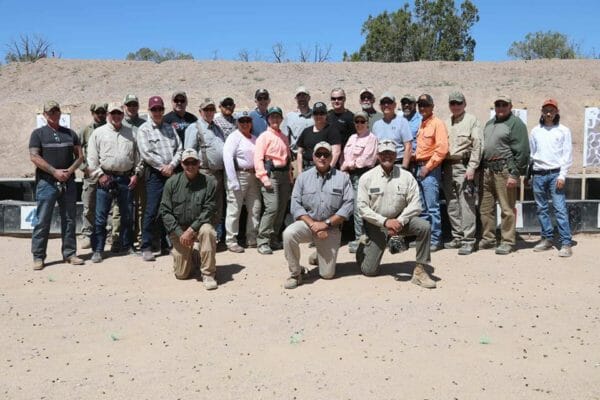
U.S.A. –-(AmmoLand.com)- If I could think of one word or phrase to describe Gunsite Academy, it would be this: The Mecca of modern firearms training in the United States. Gunsite had been on my list of places to train for several years, but due to its distance from me and the combined time and financial commitment, no progress had been made toward attending. Luckily, fate smiled upon me, and I was awarded a scholarship from the Jeff Cooper Legacy Foundation, helping me make my way to Gunsite for their week-long 250 Pistol Class. How did Gunsite live up to the legend?
Location
Gunsite Academy, Paulden, Arizona
Weather
We had decent weather throughout the entire week. Being located in Northern Arizona, temperatures got a little toasty, even in early May. Skies were clear to partly cloudy with a light breeze.
Equipment
During 250 Pistol, I used two slight variations on my equipment. Both versions were mounted to a Blue Alpha double-layer belt. Magazines were carried in Esstac Kiwi and HSGI TACO pouches. A single North American Rescue rigid CAT holder held a CAT tourniquet on the belt in case of serious boo-boos, which luckily was never needed. A Blue Force Gear admin pouch was on the belt for my notebook and other miscellaneous items. During low light portions of class I used a Bianchi Accumold pouch for my Streamlight Stinger HL.
I started class with a Glock 19 paired with a Steiner MPS carried in an Alien Gear Rapid Force duty holster. From day two of class forward I used a Glock 34 with Aimpoint ACRO carried in a Safariland 6354DO duty holster.
Personnel
We had 23 students in class, which included four women, with ages ranging from their early 20s to late 60s. Backgrounds include current law enforcement, real estate, construction, education and more, with some having next to no experience with firearms to those being extremely proficient with substantial training backgrounds.
Student Equipment
Equipment was somewhat surprisingly varied among students. Guns include SIG Sauers in the form of the P2022, P226, P220, and P320. Glocks made up a large chunk as well, including G21, G19, G34, and G23. Three Walthers appeared with the PDP, PPQM2 and Q5 Match. One student ran a GI style 1911, with another student starting with an Atlas 2011 then transitioning to an HK VP9. One Smith & Wesson Shield EZ9 struggled through class, supported by an M&P2.0 in 9mm.
Just under 25% of students were using optics. Holosun lead the way, with the 507C, 508T, and 507K making up the bulk of optics, along with a single Trijicon RMR and my Aimpoint ACRO.
Day 1 of Gunsite 250 Pistol
The day starts pretty simply, with administrative duties such as signing in, picking up our ammo packages, and meeting our instructors. We spend some time in the classroom learning about Gunsite, the rules of the range, and expectations for the coming week, topped off by the class reciting the Pledge of Allegiance.
Classroom Academics
Students have a wide range of experience, so the basics are covered in lecture. This includes the basics of the Modern Technique, Combat Triad, along with Principles of Practical Marksmanship. Next we go over the basics of sight alignment and sight picture, and the various carry conditions for our pistols. After a bit of lecture, we head down to the range.
Range Time
To start, our instructors check everyone’s gear to ensure that our equipment is in a safe condition and properly fits the wearer. Those who have issue are directed to the Pro Shop to buy or borrow loaner gear for class. Next we get our daily safety briefing, followed by instructor introductions. We will have three instructors for the duration of class: Freddie Blish, Joe Avila, and Gary Smith. Instructors have students move to the firing line with cleared guns to work on fundamentals. Here we cover the benefits of both the weaver and isosceles stances, and a modern, high grip on our gun. The morning ends with us firing five rounds into a one inch square at three yards to confirm zero on our pistols. Afterwards, we holster or store our guns, then head to lunch.
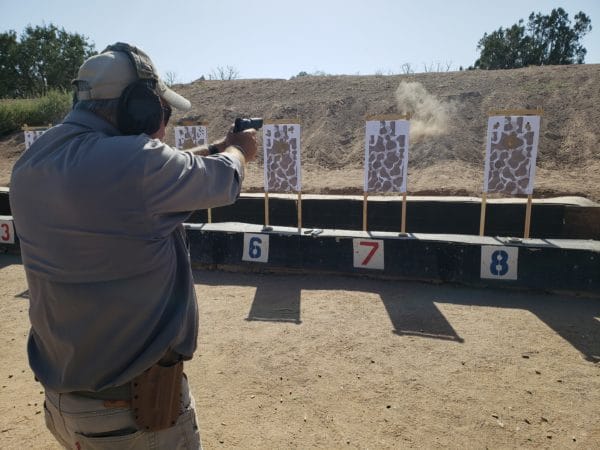
After lunch we are taught a five step method for presenting the pistol. This is the first time I’ve seen this method, ends up being one that I try for the first day then abandon for previously learned techniques. We practice the presentation dry for several reps, then move into live fire at three and five yards. Next, we learn tactical reloads and controlled pairs, working those in dry fire then live fire at three, five, and seven yards. Students have questions about appropriate trigger finger placement, which leads to a demonstration of the intricacies associated with different placement. To wrap up the day we return to the classroom.
Classroom Academics
Once back in the classroom, instructors provide us with advice on a variety of dry practice techniques to build skill without spending ammunition. After this, the on-site gunsmiths provide academics on proper maintenance of our firearms, to include recommendations on cleaning supplies, and best practices for those using red dot sights. Once the maintenance lecture concludes, we’re sent home for the evening.
Day 2 of Gunsite 250 Pistol
Day two of Gunsite 250 Pistol starts on the range. Guns begin dry, using spent brass on the front sight to work on our trigger control. This is followed by more controlled pairs, then headshots at three, five, and seven yards. It is here that we begin incorporating the use of timers and turning targets as our cue to engage the threat instead of verbal commands from the cadre. From here we practice speed reloads, then get our first practice at the School Drill which will be a graded event later in the week. Next we work on shooting with our strong side leg leading, which becomes more relevant as we build upon skills throughout class. Before lunch we introduce hammer pairs, using a single acceptable sight picture for both shots, following through afterwards.

After lunch we kick things off with a lecture on stoppages and the proper operation of the semiautomatic handgun. Instructors pass out dummy rounds for students to load in their magazines over the next few days for surprise stoppage clearance drills. With our mixed magazines, we get another attempt at the School Drill, then transition into the Failure Drill with a lecture on how it came to be. To wrap up shooting, the class has a man-on-man steel challenge, dividing us up into two groups. I win the overall challenge against a Walther PDP, earning a challenge coin. The day ends with a lecture on ballistics and shot placement, along with the proverbial 9mm versus 45ACP debate.
Day 3 of Gunsite 250 Pistol
Day three of Gunsite 250 Pistol begins in the classroom with a video lecture. Our instructor is the late Colonel Jeff Cooper, providing insight that rings as true today as when it was recorded decades ago. While any Gunsite instructor could provide the same information, there’s just something different about hearing the words spoken by Colonel Cooper. From his cadence, to the conviction with which he speaks, there’s a bit more power behind his words, even with it being just a recording.
Classroom Academics
Colonel Cooper begins by discussing commonalities in typical gun fights, but also the importance of preparing for outlier events which can require more specific skills to survive. Part of this includes the decision making process, which nearly perfectly parallels discussions still had today regarding streamlining neural pathways. He then goes into the Color Code lecture, reinforcing how that concept has become bastardized over the years as different instructors and influencers have misunderstood and rewritten that concept into things far removed from its original conception. We reinforce the Combat Triad, and Principles of Self Defense, in Cooper’s own words. Despite these concepts being decades old, they still ring true today. Once the video comes to a close, we head to the range.
Range Time
Range Time starts with more School Drill practice. Once we get in our practice run, the instructors break down differences in kneeling techniques that will help us for the graded event. We practice these dry, then live fire at fifteen yards. This is followed by the Non-Standard Response, giving the target three to six rounds to the body with an optional single round to the head. These body shots utilize one continuous sight picture, building upon the hammer pairs taught yesterday. After this we break for lunch.
Up to now, our School Drills have been shot with more generous par times. Upon returning from lunch, we get our first taste of the real par times, and some are left a little concerned at their ability to make the cut. Next we start working on 180 degree turns, first unarmed, then dry, and finally in live fire. These turns will be used for another graded event later, the El Presidente, a Gunsite standard.

At this time the class splits up, with half of us going to one of the on-site shoot houses to work single man room clearing using a blue gun and close instructor guidance. Most of the students have no experience with room clearing, and those who have worked these skills still find themselves learning new things. At the same time, the other half of class gets academics on cover versus concealment, and how to work around cover effectively. Once our task is completed, we swap with the other half of class. I manage to send a round into a barricade thanks to a pulled shot, and give the bullet hole my John Hancock. This ends day three of 250 Pistol.
Day 4 of Gunsite 250 Pistol
Day four of Gunsite 250 Pistol begins on the range. Class is split into three groups; one at the indoor simulator shoot house, another at an outdoor simulator, and the third working on School Drill and El Presidente on the range.
Range Time
I won’t delve into details on either the indoor or outdoor simulator, but the class does get feedback regarding crowding cover, failing to proactively reload before moving into new spaces, and harming no-shoot targets.
On the range, we get a little bit of dry practice in, taking aim at the head of our target using a two second par. This leads directly into the School Drill using real par times, I manage a 54/60, and a 57/60 on my first two attempts. After this we transition into shooting the El Presidente, with each student getting three attempts. I bring in a 50, 55, and then a 48 on the drill, with my last run requiring immediate action to clear a dummy round from the gun. Once students return from their events, we break for lunch.
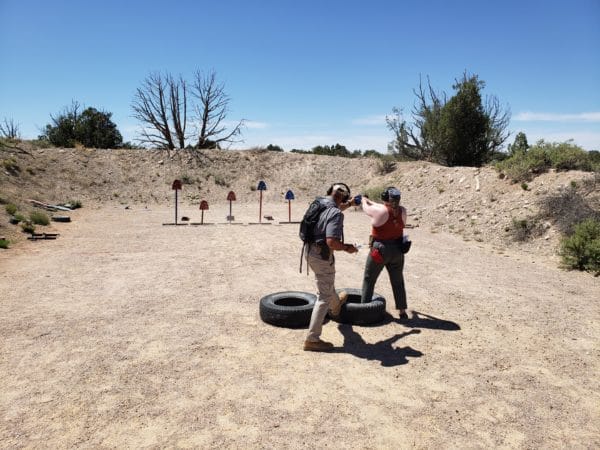
Upon returning from lunch we move into a side bay to shoot what is called the Dozier Drill. This uses steel targets, almost like a Steel Challenge stage, with my times coming in at 4.39, 4.51, and 4.41 seconds. The fastest in class was a smooth 3.80. Afterward we move back to our primary range to work on movement, followed by strong hand only practice. The afternoon is wrapped up with another run at the School Drill, where I land a 57/60. We break for dinner, having a big cookout with class on campus.
Low Light Training
After dinner we return to the range for low light training. One student stays back due to heat exhaustion, reinforcing the importance of hydration, sunscreen, and more preventative measures. With the sun low, we begin learning techniques for handheld light use with enough light to see the instruction. We work FBI, Harries and another technique, with academics on weapon-mounted lights as well.

Once darkness arrives we get to practice these techniques individually and as a group to see how they work in realistic levels of light. Next we get a lecture on light selection to include incandescent versus LED lights, brand recommendations, and more. Then the instructors have the entire class move from 50 yards to 25, and 7, with students getting to see how their light fares at each distance. Many are shocked at how poorly their lights perform, even up close, with some having barely functioning equipment.
Finally we get academics on photonic barriers, seeing how ambient light and dust can impact our handhelds. This wraps up day four of Gunsite 250 Pistol.
Day 5 of Gunsite 250 Pistol
Training day five begins much like day four, on the range. Class is once again split between the shoot house, outdoor simulator, and the range. Today our performance is being measured for our final scores, which will largely determine our rankings upon graduation.
Range Time
The first thing we notice, even before class begins is that our classmate who stayed back last night still hasn’t returned. We send a search party out, and while he’s okay, he has decided to tap, taking today to finish recovering from the day before. It’s great to see someone know their limits and prioritize safety, but an ounce of prevention is worth more than the cure. Unfortunately, this prevents him from getting a certificate at the end of the week for not finishing class.
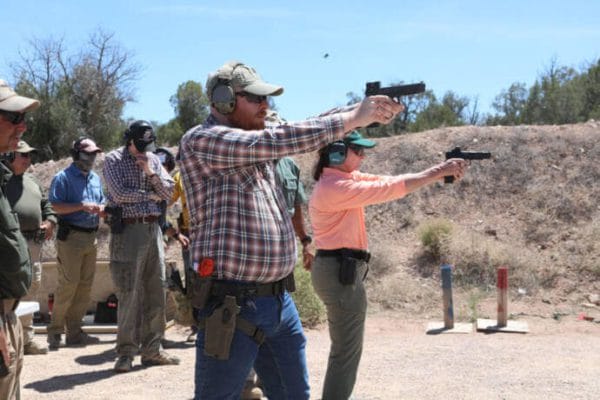
Once class begins, we work our way through the indoor and outdoor simulators. When indoors, I make a few poor shots from retention. Although I kept everything on target, I mistake a stoppage for an empty magazine while moving and performing an emergency reload. I approach the outdoor simulator with more of a gaming mindset than defensive, which results in some bad tactics on my part, but solid lessons learned. On the square range, I shoot a 57/60 and 54/60 on the School Drill for my final scores and land a 56 and 46 on my final attempts at El Presidente.
As a class, the instructors have seen significant improvement in everyone throughout the week, but critique some situational awareness and communication errors in the simulators. From here we go to a final man-on-man shoot off. My first run results in a procedural error, losing me that bout. My second attempt leads me to winning the overall match, and a hat pin as a reward.
Awards, and The Sconce
After wrapping up shooting, we head back to the classroom where awards and certificates are given out. A single hit on a hostage target costs me my Expert rating, resulting in Marksman-1, the second highest placement. Our instructors give great personalized words for each graduate, sparking emotion from some. As graduates of 250 Pistol, we are afforded the opportunity to tour the Scone, Colonel Cooper’s former home.
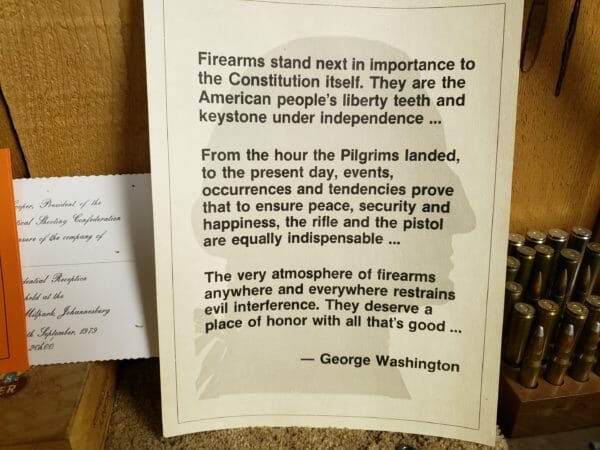
Here we are served brownies and lemonade prepared by Colonel Cooper’s daughters, who tell us the history of the home and the importance of Gunsite. As recipients of the Jeff Coop Legacy Foundation Scholarship, my wife and I chat with the daughters, along with the staff. After exploring the Sconce and talking with students and instructors, we make our exit to begin the twenty-hour drive home.
Final Thoughts on Gunsite 250 Pistol
Traveling to Gunsite is an experience like none other I’ve had in the training world. Describing it as the Mecca of American defensive firearms training is no exaggeration in my mind. The staff were friendly and knowledgeable. Colonel Cooper’s daughters help keep the legend alive.
As a five-day course, 250 Pistol does a great job at building shooters up from the basics to introducing them to more advanced concepts like movement within structures and tactics. Consider donating to the Jeff Cooper Legacy Foundation so others can have this opportunity as well, or apply for the scholarship yourself to make your way down. I’m glad I had the opportunity to make the pilgrimage, and I plan on making my return sooner than later.
If you’re looking for training, give Gunsite Academy a strong look. They teach nearly everything under the sun, from pistol, rifle, and shotgun, to predator defense, and more, Gunsite has something for you. You can check them out >>HERE<<
About Dan Reedy
Dan is an Air Force veteran, avid shooter, and dog dad. With a passion for teaching, he holds instructor certifications from Rangemaster, Agile Training & Consulting, and the NRA. He has trained with Darryl Bolke, Mike Pannone, Craig Douglas, among several other instructors, amassing over 400 hours of professional instruction thus far. In his spare time you’ll find him teaching handgun, shotgun, and less lethal classes.
Dan’s work has been published by Primer Peak, and The Kommando Blog, and he has been featured as a guest on Primary & Secondary.


Grip, Front Sight, Press, Followthrough/Scan.
Went there in 1980’s when Cooper was still around. Attended & participated in the growth & explosion of several training schools.
Anybody who attends & give themselves for a solid week of instruction that will LISTEN & learn is demonstrating the proper attitude. Student for life always learning …
Smooth is fast, fast is smooth.
I attended in August of 1981, back when Col. Cooper ran the school and taught some of the classes. All but one of our pistols were 1911 Colts, in .45 acp. I believe we had one person using a 9mm S&W.
I recall one range session where Col. Cooper was demonstrating how little recoil a .45 had by shooting dirt clods with only his thumb and trigger finger holding and operating the gun.
To someone from Florida, that dry, desert air was easy going. Yes, it was 115° in the shade, but felt like 85° back home.
Fond memories.
I have never been there, can’t afford to go BUT, I know several people who have gone through the courses. One of the things they all mentioned is being able to engage a target, starting facing away from it, turn and fire AND HIT in under one second — from surrender. A good skill for every patriot to have. The one on one “shoot off” is something everyone who shoots should practice. There is nothing like a good competition to show you both your flaws and your skills. Most people are very surprised to see how fast a real situation… Read more »